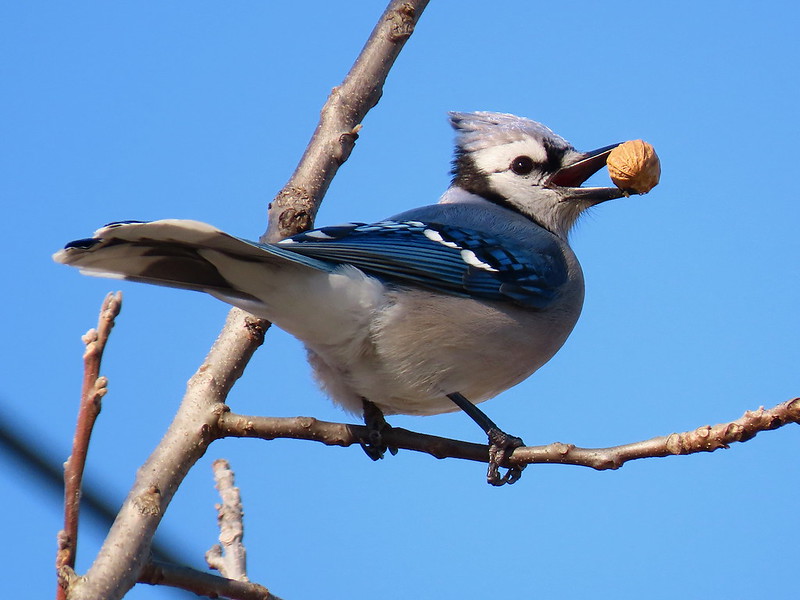By Craig Thompson
Let’s be honest, mid-February is an absolutely lousy time to ask people to count birds, but that is exactly what the National Audubon Society and Cornell Lab of Ornithology ask people to do. The weather is often intolerably cold, for people and for birds. The winter snow in some years is as deep as it gets.
This is, however, the perfect birding day if you have a bad case of the winter “blahs” and want to stretch your bird identification skills. The only birds out there are the “usual suspects”: our hearty year round species, plus a few common winter visitors, and maybe an unexpected transient bird here and there that was forced down from Canada for lack of food.
But this is precisely why counting birds during the Great Backyard Bird Count is of value to ornithologists. By now, birds have completed their migratory itineraries and are in their final winter destinations.
The Great Backyard Bird Count shows where the birds are in the dead of winter. And the neat thing is, when everyone in North America counts birds on the same weekend, you’ve got an instant crowd-sourced database which provides researchers a robust snapshot of bird distribution and abundance throughout the U.S. and Canada.
Over the four-day President’s weekend (Friday, February 16 – Monday, February 19), birdwatchers of all ages and abilities throughout North America are urged to count birds in their backyards or local parks as part of the annual Great Backyard Bird Count. Participating is easy and fun. Last year, half a million people from 200 countries contributed information to the Great Backyard Bird Count. Every bit of data helps, and you can even count from the comfort of your kitchen window.

Sponsored by the National Audubon Society, Cornell’s Laboratory of Ornithology and Bird Studies Canada, the Great Backyard Bird Count is now in its 27th year, a rich long-term survey useful for tracking changes in winter bird ranges. Birds are excellent environmental monitors, and studying fluctuations in bird abundance and/or distribution over time can reveal trends. Which then begs the question “why the trend?”,
These trends ultimately inform sound conservation strategies.
Carolina Wrens are a great example. In the Carolina Wren’s case, many attribute the apparent northward expansion of its winter range to climate change. A hundred years ago it was so unusual to see a Northern Cardinal in Western New York, at any time of year, that a young Roger Tory Peterson bicycled to Gowanda – in the winter – to verify a report. Now of course they are quite common year ‘round. You can probably guess one of the reasons why.
So, how can you contribute to the Great Backyard Bird Count bird survey at home? Merely choose a time for your backyard survey on one (or more) of the operative dates. When you “go live”, simply keep track of the highest number of individuals of each bird species that you can see in your “field of view” at any one instant during your count period, like if you took a picture. Keep “taking those pictures” and recording “highest count” data for each species for at least 15 minutes, or more if you like. Some familiarity with common winter bird species is necessary*, so keep a bird guide handy for those “gotcha” moments when a hard-to-identify bird appears.
Once you are done “counting”, log on to www.birdcount.org and create your (free) Great Backyard Bird Count account, identify your locale and then log in your data. There’s other cool stuff on that URL to peruse, too. It’s very easy to collect and to report your field data, and it is, of course, of the utmost importance to bird conservation that you actually take time to log in your data.
The Great Backyard Bird Count is a great opportunity to get to know your local birds better and to be involved in bona fide ornithological science at the same time. No other scientific discipline has relied so heavily on raw data gathered from everyday people. Thanks to this and other citizen science programs such as the National Audubon Society’s Christmas Bird Count, NYS DEC’s Breeding Bird Atlas, and Cornell’s Project FeederWatch and its E-bird database, the active engagement of rank amateurs has been critical to the advancement of bird conservation.
But just a word of warning: bird watching can be habit forming.
The top 10 bird species reported during the Great Backyard Bird Count are Northern Cardinal, Mourning Dove, Dark-eyed Junco, American Goldfinch, Downy Woodpecker; Blue Jay, House Finch, Tufted Titmouse, American Crow, and Black-capped Chickadee. Easy-peezy!
Audubon Community Nature Center builds and nurtures connections between people and nature. ACNC is located just east of Route 62 between Warren and Jamestown. The trails are open from dawn to dusk and birds of prey can be viewed anytime the trails are open. The Nature Center is open from 10 a.m. until 4:30 p.m. daily except Sunday when it opens at 1 p.m. More information can be found online at auduboncnc.org or by calling (716) 569-2345. Craig Thompson leads bird walks at the Roger Tory Peterson Institute and can often be found birding on the trails at Audubon.
For more information on the Great Backyard Bird Count, go to https://www.birdcount.org/


Recent Comments